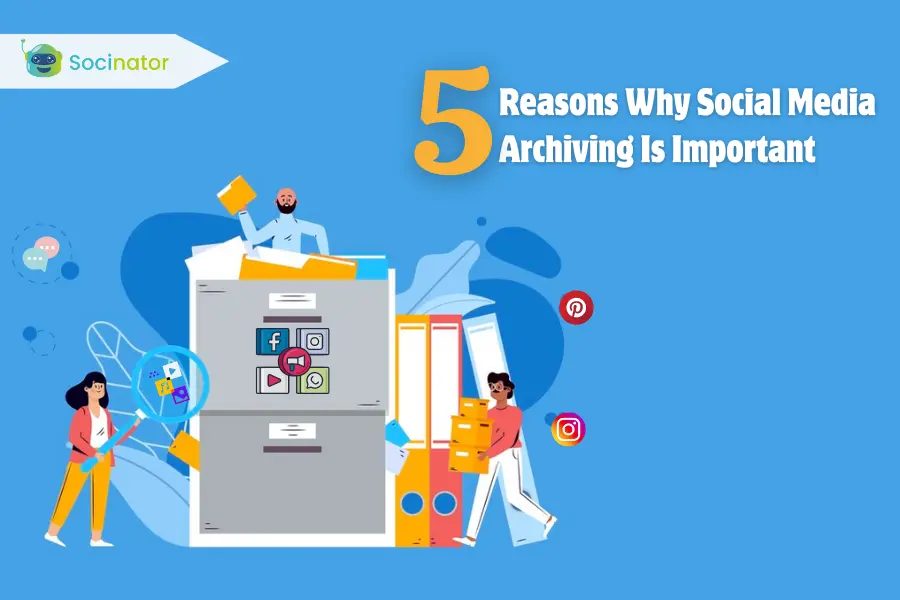Have you ever wondered about the lasting impact of your social media interactions? Social media platforms serve as dynamic canvases for our thoughts, experiences, and connections. But what happens to this ever-flowing stream of content? How can we preserve our digital footprint and navigate the legal complexities that may arise? In such conditions, Social Media Archiving comes into play.
It is a practice designed to capture, store, and manage the bunch of information generated in the virtual spaces we inhabit daily. But why is it so crucial? Twice-fold, it safeguards our digital legacies and ensures compliance with regulations, offering a comprehensive solution for businesses, government bodies, educational institutions, and individuals alike.
Let’s explore the significance of archiving, a strategic imperative in an era where the digital landscape evolves rapidly. This blog aims to cover the basics of media archiving. From where the data gets stored to the reasons why it is so pivotal to marketers and brands.
Hit ‘Play’ Button & Tune Into The Blog!
Where Is Social Media Content Archived?
Social media content archives through specialized archiving solutions and tools designed to capture, store, and manage the vast amounts of data generated on various platforms. The archival process includes systematically gathering and safeguarding digital content from social media platforms.
Here are the usual methods and locations for social media content archiving:
Third-Party Archiving Services:
Numerous third-party services offer social media archiving solutions. These services often provide comprehensive tools to capture and store content from multiple platforms.
Archiving Software:
Organizations can use dedicated archiving software to capture and retain social media content. These tools often provide customization options and compliance features to meet organizational needs.
Cloud Storage Platforms:
Some organizations opt to archive social media content on cloud storage platforms such as Amazon S3, Google Cloud Storage, or Microsoft Azure. These platforms offer scalable and secure storage solutions for digital content.
In-House Servers and Databases:
Larger organizations perform social media pigeonholing using in-house servers and databases. This approach provides more control over data management and security.
Compliance and Regulatory Platforms:
Businesses in highly regulated fields, such as finance and healthcare, frequently use specialized compliance and regulatory platforms that offer social media archiving capabilities to satisfy legal requirements.
Backup Systems:
Regular backups of social media content can be part of an organization’s archiving strategy. It ensures that even if content gets deleted on the platform, a copy is available for archival purposes.
The choice of where to archive social media content depends on factors like the scale of operations, regulatory requirements, and the specific features offered by archiving solutions. Regardless of the method, social media storing or archiving is essential for preserving digital history, meeting legal obligations, and managing the risks associated with online communication.
How Does Archiving Social Media Work?
 Storing social media involves a systematic process to capture, store, and manage digital content effectively. Here’s a simplified overview in five steps:
Storing social media involves a systematic process to capture, store, and manage digital content effectively. Here’s a simplified overview in five steps:
Step-1: Snapshot and Context Deciphering
Proficient social media archiving captures data snapshots, allowing investigators to decipher context. The context holds significance, and a vital compliance factor involves implementing a “write once read many” (WORM) system. Data cannot be overwritten or changed after creating a snapshot.
Step 2: Immutable Storage for Compliance
Consider a scenario where a social media post’s snapshot gets stored in a PDF. Ensure that the PDF is stored in a manner that prevents changes, maintaining compliance. Users and admins can’t change the file. Make a new one for extra snapshots of the post.
Step 3: Searchable Archives with Navigation
The organization’s archive system must support search functionality. Authorized users, such as administrators and legal representatives, should search archives for posts using keywords, filters, dates, and platforms. Search results should facilitate easy navigation through each post, ensuring effective review during investigations and compliance adherence.
Step-4: Dynamic or Static Archiving
Social media archiving methods can be either static or dynamic. Static PDF files encapsulate a snapshot of a social media post, preserving links and comments within the file. Dynamic systems provide custom search functionality that empowers an organization’s legal team. It helps the team to discover data and related posts efficiently through a single search.
Step-5: Enhanced Accessibility and Compliance
The chosen archiving system, whether static or dynamic, enhances accessibility during investigations and maintains compliance. By adopting these practices, the organization ensures that its social media archive remains a valuable resource for context-rich information, supporting regulatory requirements and legal scrutiny.
Why Social Media Archiving Is Important
 Here are five reasons social media storage is pivotal for sales and marketing plan.
Here are five reasons social media storage is pivotal for sales and marketing plan.
Reason 1: Efficient Social Media Content Management
Managing content across diverse social media channels demands significant time and effort. Businesses must arrange content, manage profiles, and monitor social activities across various platforms. Content archiving consolidates these tasks into a single, accessible location.
Benefits for Marketers and Salespeople:
- Quick keyword, tag, or hashtag searches become seamless.
- Access related content and information promptly.
- Utilize analytics features to identify the most popular content.
- Enhance efficiency, impacting aspects from time management to customer relations.
Reason-2 Effortless Reputation Management
Social media archiving simplifies online reputation management by consolidating brand mentions across platforms. This process aids in identifying and addressing negative trends swiftly. Archiving solutions enhance monitoring by tracking audience sentiment and analyzing profitable content topics.
Invaluable Information from Archiving Solutions:
- Access a wealth of information about your channels.
- Proactively prevent brand compromise by addressing problems promptly.
- Respond quickly to customer praise and reviews, fostering a positive brand association.
Reason-3: Ensuring Legal Compliance through Archiving
Social media archiving social content centrally guarantees compliance and prevents legal repercussions. Secure content sharing with third parties, including regulatory authorities, is facilitated.
Overlooked Importance of Archiving:
- Marketers and salespeople might avoid the importance and advantages of archiving social media content.
- Integral for managing social media activity, brand reputation, and audience sentiment.
Reason-4 Enforcing Social Media Policies through Archiving
Most companies incorporate a social media section in their employee handbook, emphasizing the importance of a clearly defined policy. A well-defined policy is crucial for preventing inappropriate content, avoiding awkward interactions, and maintaining strong employer branding.
Archiving’s Role in Policy Enforcement:
- Through the tracking of keywords and the setup of notifications and alerts, archiving social content aids in policy enforcement.
- This feature ensures comprehensive monitoring of all social media activities related to a specific brand.
- It includes overseeing official brand pages and ensuring adherence to rules and best practices by staff and the general public.
Reason-5: Enhances Social Media Management
Companies today maintain a robust social media presence across various platforms, tasking marketers with overseeing activities on multiple channels.
Whether your focus is on platforms like LinkedIn, Twitter, and Instagram to engage consumers, centralized social media archiving tools prove instrumental in optimizing efforts and saving valuable time.
Implementing an archiving tool enables you to:
- Identify and repurpose your most valuable content
- Gain a comprehensive view of your audiences
- Recognize profitable content topics and potential customers
- Tailor messages to target specific audiences
- Allocate resources more efficiently
- Better manage your social media budget
Using automation tools like Socinator, helps you streamline your social media activity and maintain your online presence.
Socinator- Social Media Archives And Management Tool
 Socinator is a social media automation tool designed to enhance users’ social media presence across various platforms.
Socinator is a social media automation tool designed to enhance users’ social media presence across various platforms.
From an archival viewpoint, Socinator may have features that help store and manage social media content. While not specifically an archiving tool, it may provide functionalities that support elements of social media archiving:
Content Scheduling And Posting:
Socinator allows users to schedule posts across multiple social media platforms. This feature can contribute to organizing content and ensuring a consistent posting schedule, which is valuable for archiving purposes.
Automation:
Socinator’s automation feature enables you to communicate with followers and prospects across various social media platforms. Users can schedule personalized messages, replies, and greetings to maintain engagement and foster relationships effortlessly.
This feature streamlines communication workflows, saves time, and enhances user interaction and outreach efforts.
Analytics and Reporting:
Utilizing the analytics and reporting features of the tool can provide valuable insight into the performance of social media content. This data is significant for archiving and analyzing trends over time.
User Engagement and Interaction:
Socinator’s capabilities in managing user engagement, comments, and interactions can contribute to the preservation of a comprehensive record of social media activities.
Although Socinator is not specifically for social media archiving, its features can complement archiving efforts by providing content management, monitoring, and analysis tools.
For organizations with a comprehensive social media strategy, Socinator’s features could play a role in facilitating a more organized and streamlined approach to media archiving.
Read More
How To Build Successful Social Media Marketing Plan For 2024
Social Media Automation Explained: Why You Need It
Challenges and Considerations in Social Archiving
Media archiving is a critical practice, but its implementation is incomplete without challenges and considerations. Navigating these issues is essential to ensure the effectiveness and compliance of archiving strategies. Below are key challenges and considerations in media archiving:
Evolving Nature of Online Platforms
- Rapid changes in social media platforms pose challenges in keeping archiving systems compatible with emerging features and functionalities.
- Adapting to algorithmic updates requires continuous monitoring and adjustments to archiving processes.
Privacy Concerns:
- Maintaining trust requires balancing the collection of comprehensive data with privacy concerns.
- Compliance with data protection regulations, such as GDPR, requires careful handling of personal information in the social media archiving process.
- Ensuring transparency and obtaining user consent for archiving activities are essential considerations.
Implementation Challenges:
- Integrating archiving solutions with existing systems may present technical hurdles.
- User training and adoption of archiving tools require effective communication and support to ensure successful implementation.
- Resource allocation and budget constraints can impact the deployment and maintenance of archiving systems.
Data Security:
- Protecting archived data against cyber threats is paramount to prevent unauthorized access or data breaches.
- Implementing secure storage solutions and access controls is critical for safeguarding sensitive information.
- Adhering to encryption standards enhances the overall security of archived data.
Let’s Archive Together
Social media archiving is pivotal for businesses navigating the dynamic digital landscape. Socinator, a robust social media marketing tool, contributes to efficient archiving by aiding content scheduling, automation, and monitoring. While not a dedicated archiving tool, Socinator’s features synergize with organizational efforts, facilitating a comprehensive approach.
As social media platforms evolve, archiving remains integral for preserving digital legacies, ensuring compliance, and enhancing reputation management. Despite challenges, the commitment to proactive strategies, including continuous adaptation and secure data practices, positions media archiving as a strategic imperative for organizations aiming to harness the full potential of their digital presence.






